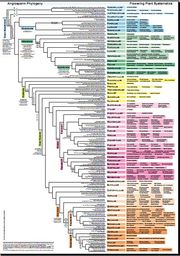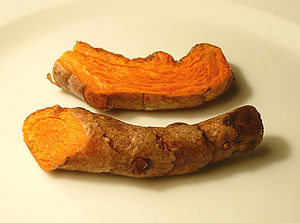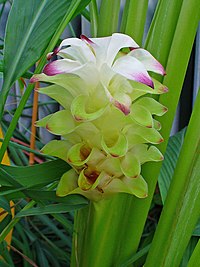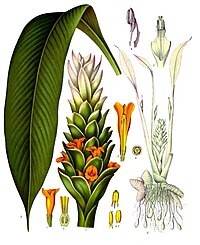Curcuma longa
Read community contributed articles on biodiversity & environment || Cultural practices & mythological stories related to Indian biodiversity || Official documents related to environment || NGOs, Blogs and Websites || Environment-related video collection || Plants of India || Mammals of India || Facebook || Twitter
Share this page: Curcuma longa
Curcuma longa or Turmeric is a plant with high medicinal and cultural value in India. The rhizome of the plant has medicinal properties. The dried root is ground into a powder which is used on several religious occasions in Hinduism. India is the largest producer of Turmeric in the world. (Adapted from Wikipedia)
Click here to see all Semantic Properties associated with this page
Please note that the above slideshow is automatically created by searching Flickr and does not contain manually curated images. Hence, it is likely that some images may not be exactly of Curcuma longa.
Click on the tabs below to know more...
- Species identity and nomenclature
- Current Wikipedia entry
- Binomial Classification
- Morphological features
- Habitat and Geographical Spread
- Maps
- Medicinal Importance
- Cultural significance
- Commercial importance and cultivation
- Summary of PubMed articles
- Summary of NCBI molecular data
- External Links
- Images and Videos
| Parameter | Value(s) | References See complete references in the References section at the end |
|---|---|---|
| Names of users who have contributed to this species page | Gauravm | |
| Date on which this page was first created | 2010/08/14 | |
| This page was last modified on: | 8 September 2010 17:53:15 | |
| Name of the species | Curcuma longa | |
| ID on Encyclopedia of Life | ||
| Synonyms | Please check Binomial Classification section for synonyms. | |
| Common English Names | Common Turmeric | |
| Common Hindi Names | हल्दी Haldi | |
| Common Indian names | হালধি, Halodhi (Assamese); হলুদ Halud (Bengali); હળદર Haldar (Gujarati); हल्दी Haldi (Hindi); Arishina, Arisina (Kannada); മഞ്ഞള്, Manjal (Malayalam); हळद Halad (Marathi); हल्दी Haldi (Nepali); Haladi (Oriya); Haridra, Marmarii (Sanskrit); மஞ்சள் Manjal (Tamil); హరిద్ర, Haridra (Telugu); Haldi, ہلدی (Urdu) | Flowers of India |
| Origins/Meanings of the common names |
Taxonomy from Encyclopedia of Life
If nothing is displayed in this section, it means the EoL ID has not been defined. Please click on Edit with form button on top and follow the instructions for filling in the EoL ID
{{#EoLOnlyHierarchy:}}
Taxonomy filled in form

Click here for the PDF of the phylogeny
| Taxon | Value |
|---|---|
| Regnum (Kingdom) | Plantae |
| Division | Magnoliophyta |
| Class | Liliopsida |
| Order | Zingiberales |
| Family | Zingiberaceae |
| Genus | Curcuma |
| Source of data | Encyclopedia of Life |
| ||||||||||||||||||||
| Division | Taxon details | Taxon morphology details |
|---|---|---|
| Magnoliophyta | Also called Angiospermae. The ancestors of flowering plants diverged from gymnosperms around 245–202 million years ago, and the first flowering plants known to exist are from 140 million years ago. They diversified enormously during the Lower Cretaceous and became widespread around 100 million years ago, but replaced conifers as the dominant trees only around 60-100 million years ago. | These are seed plants like Gymnosperms, but can be differentiated by the presence of flowers, seeds containing endosperm and seeds that produce a fruit. Angiosperms are the most diverse and highly evolutionarily successful group of land plants. |
| ||||||||||||||||||||
| Class | Taxon details | Taxon morphology details |
|---|---|---|
| Liliopsida | Liliopsida is considered the scientific name for monocots, but monocots may be called differently based on different taxonomic classification systems. Based on chloroplast DNA sequences, the divergence date between monocots and dicots is estimated to be ~200 million years, with a 40 million years uncertainty. There are ~50000-60000 species of monocots, with the largest family being Orchidaceae (orchids) consisting of ~20000 species. The true grasses (Poaceae) are the most economically important family, with 70% of the crops being cultivated belonging to this family. | The following features distinguish monocots from dicots - 1) Three flower parts in each flower (vs 4-5 in dicots) 2) One pore in pollen (vs 3) 3) One cotyledon (vs 2) 4) Vascular bundles in stem scattered (vs concentric circles) 5) Adventitious roots (vs radicle-origin) 6) Parallel venation (vs reticulate) These broad distinguishing features indeed have some exceptions |
| ||||||||||||||||||||
| ||||||||||||||||||||
| Family | Taxon details | Taxon morphology details |
|---|---|---|
| Zingiberaceae | Zingiberaceae split off from the genus Costaceae ~79 or ~100 million years ago, based on two estimates (Kress06,Janssen04). The family consists of over 93 genera and over 2000 different species, with the center of diversity in South-East Asia. | Small to large herbaceous plants, distichous leaves with basal sheaths that overlap to form a pseudostem. Plants are either self-supporting or epiphytic. Flowers are hermaphroditic, usually strongly zygomorphic (bilateral symmetry), in determinate cymose inflorescences, with conspicuous, spirally arranged bracts. The perianth is composed of two whorls, a fused tubular calyx, and a tubular corolla with one lobe larger than the other two. Flowers typically have two of their stamenoids (sterile stamens) fused to form a petaloid lip, and have only one fertile stamen. The ovary is inferior and topped by two nectaries, the stigma is funnel-shaped. |
|
Based on classification
| Family | Taxon details | Taxon morphology details |
|---|---|---|
| Zingiberaceae | Zingiberaceae split off from the genus Costaceae ~79 or ~100 million years ago, based on two estimates (Kress06,Janssen04). The family consists of over 93 genera and over 2000 different species, with the center of diversity in South-East Asia. | Small to large herbaceous plants, distichous leaves with basal sheaths that overlap to form a pseudostem. Plants are either self-supporting or epiphytic. Flowers are hermaphroditic, usually strongly zygomorphic (bilateral symmetry), in determinate cymose inflorescences, with conspicuous, spirally arranged bracts. The perianth is composed of two whorls, a fused tubular calyx, and a tubular corolla with one lobe larger than the other two. Flowers typically have two of their stamenoids (sterile stamens) fused to form a petaloid lip, and have only one fertile stamen. The ovary is inferior and topped by two nectaries, the stigma is funnel-shaped. |
More details can be found in the Binomial Classification section.
Morphology from Encyclopedia of Life
If nothing is displayed in this section, it means the EoL ID has not been defined. Please click on Edit with form button on top and follow the instructions for filling in the EoL ID
{{#EoLOnlyDescription:}}
General morphology
| Parameter | Value(s) | References See complete references in the References section at the end |
|---|---|---|
| General morphological features of the plant | Plants ca. 1 m tall. Rhizomes many branched, orange or bright yellow, cylindric, aromatic; roots tuberous at tip. Petiole 20-45 cm; leaf blade green, oblong or elliptic, 30-45 cm long, 15-18 cm wide, glabrous, base attenuate, apex shortly acuminate. Inflorescences terminal on pseudostems; peduncle 12-20 cm; spike cylindric, 12-18 cm long, 4-9 cm wide; fertile bracts pale green, ovate or oblong, 3-5 cm, apex obtuse; coma bracts spreading, white and green, sometimes tinged reddish purple, apex acute. Calyx white, 0.8-1.2 cm long, puberulent, apex unequally 3-toothed. Corolla pale yellow; tube to 3 cm; lobes deltoid, 1-1.5 cm, central one larger, apex mucronate. Lateral staminodes shorter than labellum. Labellum yellowish with central, yellow band, obovate, 1.2-2 cm. Anther spurred at base. Ovary sparsely hairy."Plants ca. 1 m tall. Rhizomes many branched, orange or bright yellow, cylindric, aromatic; roots tuberous at tip. Petiole 20-45 cm; leaf blade green, oblong or elliptic, 30-45 cm long, 15-18 cm wide, glabrous, base attenuate, apex shortly acuminate. Inflorescences terminal on pseudostems; peduncle 12-20 cm; spike cylindric, 12-18 cm long, 4-9 cm wide; fertile bracts pale green, ovate or oblong, 3-5 cm, apex obtuse; coma bracts spreading, white and green, sometimes tinged reddish purple, apex acute. Calyx white, 0.8-1.2 cm long, puberulent, apex unequally 3-toothed. Corolla pale yellow; tube to 3 cm; lobes deltoid, 1-1.5 cm, central one larger, apex mucronate. Lateral staminodes shorter than labellum. Labellum yellowish with central, yellow band, obovate, 1.2-2 cm. Anther spurred at base. Ovary sparsely hairy." cannot be used as a page name in this wiki. | EoL through Plants of Tibet |
| Seed dispersal mechanism | ||
|---|---|---|
| Bloom type | Perennial | |
| Life cycle of the plant |
How to identify this species
For a detailed description, refer to the General Morphology details above
| Parameter | Value(s) | References See complete references in the References section at the end |
|---|---|---|
| Type of plant | Herb | |
| Plant height | 3 feet to 6 feet | EoL through Plants of Tibet |
| Flower color | White | Gauravm,based on images |
| Flower shape | ||
| Floral symmetry | ||
| Phyllotaxy of leaves | Opposite | |
| Leaf shape | Oblong | EoL |
| Is the leaf petiolated or sessile? | Petiolated | EoL |
| Is the leaf simple or compound? | Simple | Based in images |
| Parameter | Value(s) | References See complete references in the References section at the end |
|---|---|---|
| IUCN Conservation Status | Not Evaluated | EoL |
| Indian States in which the species has been documented | Assam,Andhra Pradesh,Bihar,Chhatisgarh,Goa,Karnataka,Madhya Pradesh,Maharashtra,Meghalaya,Orissa,Sikkim,Tamil Nadu,Uttar Pradesh,West Bengal | Plant Database of India |
| Locations at which the species has been documented | Amaravati;Bangalore;Bhopal;Chamoli;Champaran;Goa;Gorakhpur;Guntur;Jowai;Kolhapur;Lakhimpur;Madras;Mundage;Nagpur;Osmanabad;Raipur;Salem;South Arcot;Tambaram;Tiruchi;Udupi;Varanasi | Plant Database of India |
| Biotic zones inhabited | Eastern Ghats, Western Ghats, Central Deccan Plateau, Indo-Gangetic Plain | Gauravm |
| Details about the habitat | Cultivated, Cultivated fields and Plains, Fields,Gardens, Kitchen gardens,Shaded moist places & Rocky Cliffs in primary forests | Plants Database of India |
| Is this species native to India? | Yes | GRIN,EoL |
| Is the species indigenous/endemic to Sub-Himalayan regions? | ||
| Is the species indigenous/endemic to Western Ghats? | Yes | GRIN,EoL |
| Is the species indigenous/endemic to Eastern Ghats? | Yes | GRIN,EoL |
More plants native to India
| ||||||||||||||||||||||||||||||||||||||||||
If no maps are displayed below, it means the required data is absent. Click on "Edit with form" button on top of the page to add this information.
{{#generateMap:Assam,Andhra Pradesh,Bihar,Chhatisgarh,Goa,Karnataka,Madhya Pradesh,Maharashtra,Meghalaya,Orissa,Sikkim,Tamil Nadu,Uttar Pradesh,West Bengal|Curcumalonga_brahma.svg|align=center}}
| Parameter | Value(s) | References See complete references in the References section at the end |
|---|---|---|
| Does this species have any medicinal use? | Yes |
|
Other plants of the same family having medicinal use:
| ||||||||||||||||||||||||||||||
| Parameter | Value(s) | References See complete references in the References section at the end |
|---|---|---|
| General types of ailments this species is used for treating | Infectious diseases, Accidents, Pains and Inflammation, Common ailments, Systemic disorders, Organ-specific disorders, Cancer | |
| Specific ailments for which the species is used | Blood clot prevention, Cancer, Cognitive function, Dyspepsia, Gall stone, High cholesterol, AIDS, Inflammation, Irritable bowel syndrome, Liver protection, Osteoarthritis, Peptic ulcers, Rheumatoid Arthritis, Scabies, Uveitis, Viral infection, Alzheimer's disease | Medlineplus, WikiCurcumin, Hatcher08 |
| Medicinal systems which use this plant | Ayurveda | |
| Details of Medicinal use | Although several studies have shown efficacy of using turmeric for many diseases, reliable scientific evidence is lacking for many conditions. The important active component is a polyphenol called Curcumin. It has been shown to have antioxidant, antibiotic, antitumor, antiamyloid, antiischemic and antiinflammatory properties. See molecular details more more specific mode of action. | WikiCurcumin, Hatcher08 |
| Parts of the plant used for treatment | Root, Rhizome, Leaves | Himalaya |
| Names of some medicinal active compounds in this plant, if known. | Curcumin, Curcumin derivatives, Turmeronol, Curcumerone, Turmerone, stigmasterol, ß-sitosterol, anthraquinone | Himalaya Monographs |
| Details of the active chemical compounds found in this plant | Curcumin is the active ingredient in the traditional herbal remedy.Curcumin has a surprisingly wide range of beneficial properties, including anti-inflammatory, antioxidant, chemopreventive and chemotherapeutic activity. The pleiotropic activities of curcumin derive from its complex chemistry as well as its ability to influence multiple signaling pathways, including survival pathways such as those regulated by NF-κB, Akt, and growth factors; cytoprotective pathways dependent on Nrf2; and metastatic and angiogenic pathways. Curcumin is a free radical scavenger and hydrogen donor, and exhibits both pro- and antioxidant activity. It also binds metals, particularly iron and copper, and can function as an iron chelator. Curcumin is remarkably non-toxic and exhibits limited bioavailability. Curcumin exhibits great promise as a therapeutic agent, and is currently in human clinical trials for a variety of conditions, including multiple myeloma, pancreatic cancer, myelodysplastic syndromes, colon cancer, psoriasis and Alzheimer’s disease. | Hatcher08 |
| Is the molecular basis of the medicinal action known? | Yes | |
| Details of molecular basis of action | Reduces beta amyloid plaques, Reduces amount of LDL. In HIV, Curcumin may act by interfering with P300/CREB-binding protein (CBP). Low concentrations may also inhibit Herpes Simplex Virus (HSV) by inhibiting the recruitment of RNA pol II to viral DNA.
Curcumin prevents lipid oxidation by upregulating Glutathione S transferase, an antioxidant enzyme. It causes an upregulation of the Brain Derived Neurotropic Factor (BDNF) causing neurogenesis in the brain. More detailed mechanisms with references are noted on Wikipedia entry on Curcumin (See references) |
Medlineplus, WikiCurcumin |
| Are the toxic effects of consumption of this plant known? | Yes | Drugs.com |
| Details of the toxic effects of the plant species | Excessive turmeric intake has been documented to stimulate menstruation and cause abortion. Despite several clinical trials performed, not a lot of adverse reactions have been reported, except for rare cases of contact dermatitis and anaphylaxis. An increased risk of kidney stones is possible in susceptible individuals.
No reports of toxicity have been reported following ingestion of large amounts of turmeric. Turmeric may cause stomach upset upon large scale ingestion. Nausea/Diarrhoea have been reported. Curcumin not advised for people with gallstones as one report shows it may cause gallbladder squeezing. Not to be consumed in large amounts by people with immune system deficiencies or with hypoglycemic blood. |
Drugs.com, Medline |
| Have there been validation/clinical studies related to this plant? | Yes | Drugs.com |
| Details of the clinical studies related to the plant species | As of 2008, numerous clinical trials in humans were underway, studying the effect of curcumin on various diseases including multiple myeloma, pancreatic cancer, myelodysplastic syndromes, colon cancer, psoriasis, and Alzheimer's disease. | WikiCurcumin, Hatcher08 |
| Parameter | Value(s) | References See complete references in the References section at the end |
|---|---|---|
| Is this plant/plant-derived product used in food preparations? | Yes | User-reported |
| Part(s) of the plant used in the food preparations | Rhizomes | |
| Details of use in food preparations | Turmeric powder is widely used in cooking in several parts of the world. In Indian cuisine, it is used as a spice in many dishes. | |
| Does this species have any religious significance? | Yes | User-reported |
| Religions which mention/give significance to this species | Hinduism | EoL through Plants of Tibet |
| Religious occasions | Hindu Puja, Weddings | Gauravm |
| Details of religious use | Turmeric paste is applied to the body of the bride before marriage to cleanse the body and make it more radiant. On religious occasions, Turmeric is applied to the forehead of devotees and also the forehead of the statues of gods. | Gauravm |
| Parameter | Value(s) | References See complete references in the References section at the end |
|---|---|---|
| Is this plant cultivated commercially in India? | Yes | |
| Uses for which the plant is commercially cultivated | Human consumption, Agricultural use, Medicinal use, Cosmetic use, Ornamental use, Religious use | Gauravm |
| Plant parts of commercial value | Rhizomes | Gauravm |
| Products where this plant is used | User-reported | |
| Description of use | ||
| States where this plant is cultivated commercially | ||
| Best period for planting this plant | ||
| Best period for harvesting this plant | ||
| Method of propagation | Seeds, Vegetative propagation | |
| Water requirement of this plant | Average | |
| Pests and Diseases affecting this plant during cultivation | ||
| Other considerations while cultivating this plant |
Pubmed Word cloud
This word cloud is obtained using the tool LigerCat by searching the Pubmed database. LigerCat builds the cloud from the most relevant Medical Subject Headings (MeSH) terms. Each term's relative size indicates how many times it appears in the PubMed search results. Click on a term to access the full LigerCat cloud, with live PubMed search capabilities. LigerCat has been developed for the Biology of Aging Project.
The page may take some time to load since LigerCat is searching the entire PubMed database and sending us the results in real time.
- If there is an error message below, it means that there is no retrievable information available on NCBI
- If the number of nucleotide sequences is less than 100, very little genomic work has been done on this species. A respectable number of nucleotide sequences is above 10000.
- Most of the nucleotide sequences may come from three sources:
- Studies on single genes, where people try to sequence genes such as some specific dehydrogenases important,say, for tannin production
- Sequences of Ribosomal Internal Transcribed Spacer, whose sequence is used for generating molecular phylogenetic trees to establish species relationships
- Expressed Sequence Tags (ESTs) which can tell about which genes are present and expressed in the species at a particular time in the given tissue
{{#queryDB:taxonomy |Curcuma longa }}
| Parameter | Value(s) | References See complete references in the References section at the end |
|---|---|---|
| Details of modern scientific knowledge available for this species | ||
| Are herbarium specimen available for this species? | ||
| Institutes having herbarium samples |
If nothing is displayed in this section, it means the EoL ID has not been defined. Please click on Edit with form button on top and follow the instructions for filling in the EoL ID
{{#EoLOnlyAdditionalInfo:}}
References
Hatcher08 (Journal) : Hatcher et al (2008),Curcumin: From ancient medicine to current clinical trials, CELLULAR AND MOLECULAR LIFE SCIENCES:65(11):1631. doi=10.1007/s00018-008-7452-4
EoL (Web): EoL entry on turmeric, Accessdate=2010-08-14
Flowers of India (Web): Flowers of India entry on turmeric, Accessdate=2010-08-14
Drugs.com (Web): Drugs.com entry on Turmeric, Accessdate=2010-08-14
Dr. Duke (Web): Chemicals and their Biological Activities in: Curcuma longa L. (Zingiberaceae) -- Indian Saffron, Turmeric, Accessdate=2010-08-14
Himalaya Monographs (Web): Turmeric entry, Accessdate=2010-08-14
Plants Database of India (Web): Plants Database of India, Accessdate=2010-08-18
Medlineplus (Web): Turmeric (Curcuma longa Linn.) and Curcumin, Accessdate=2010-09-08
| This article is a stub. You can help Project Brahma by expanding it. |



